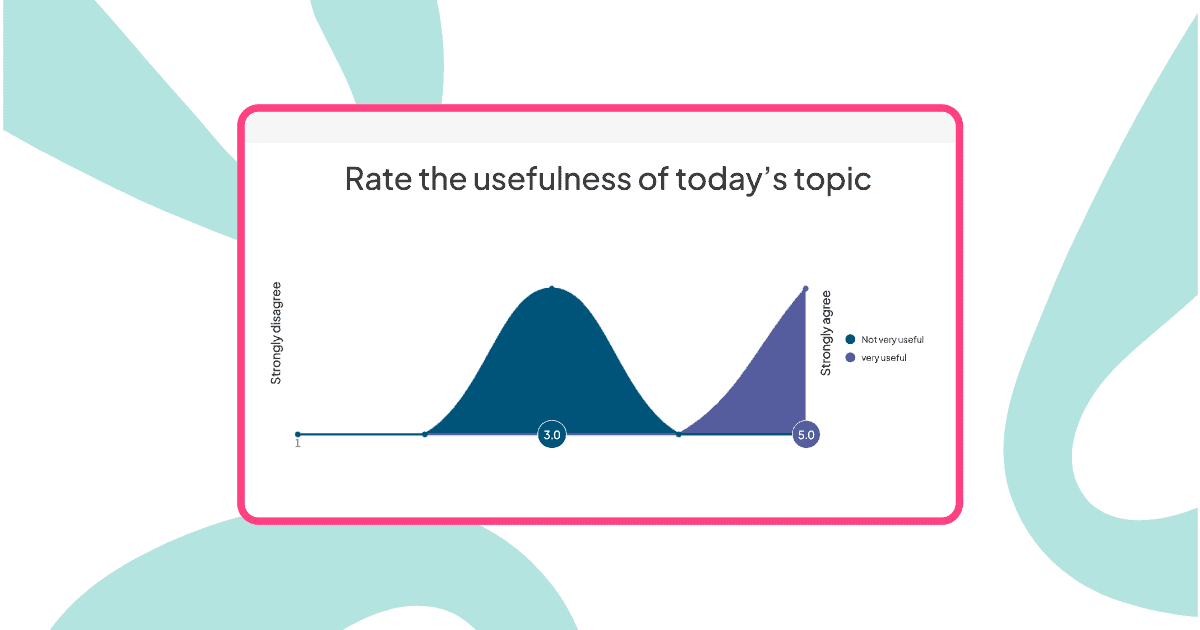Èske w te janm mande tèt ou kijan anplwaye ou yo santi yo tout bon vre konsènan wòl yo, kontribisyon yo, ak satisfaksyon yo nan travay an jeneral?
Yon karyè ki bay satisfaksyon pa limite a yon chèk peman nan fen mwa a ankò. Nan epòk travay a distans, orè fleksib, ak wòl travay k ap evolye, definisyon satisfaksyon travay chanje dramatikman.
Men pwoblèm nan: sondaj anyèl tradisyonèl yo souvan bay ti pousantaj repons, enfòmasyon an reta, ak repons ki pa dezenfekte. Anplwaye yo ranpli yo poukont yo nan biwo yo, dekonekte ak moman an epi yo pè pou yo pa idantifye yo. Lè ou rive analize rezilta yo, pwoblèm yo swa vin pi grav oswa yo bliye yo.
Gen yon pi bon fason. Sondaj satisfaksyon travay entèaktif ki fèt pandan reyinyon ekip, asanble piblik, oswa sesyon fòmasyon yo kaptire fidbak otantik nan moman sa a—lè angajman an pi wo epi ou ka adrese enkyetid yo an tan reyèl.
Nan gid sa a, nou pral bay 46 kesyon echantiyon pou kesyonè satisfaksyon travay ou a, montre w kouman pou transfòme sondaj estatik an konvèsasyon kaptivan, epi ede w devlope yon kilti espas travay ki nouri angajman anplwaye yo, ki pouse inovasyon, epi ki prepare teren an pou yon siksè dirab.
Table of Contents
- Ki sa ki yon kesyonè satisfaksyon travay?
- Poukisa ou ta dwe fè yon kesyonè sou satisfaksyon travay?
- Diferans ki genyen ant sondaj tradisyonèl ak sondaj entèaktif
- 46 Kesyon Egzanp pou yon Kesyonè Satisfaksyon Travay
- Kijan Pou Fè Yon Sondaj Satisfaksyon Travay Efikas Avèk AhaSlides
- Poukisa Sondaj Entèaktif yo Fonksyone Pi Byen Pase Fòm Tradisyonèl yo
- Kle Takeaways
Ki sa ki yon kesyonè satisfaksyon travay?
Yon kesyonè sou satisfaksyon travay, ke yo rele tou yon sondaj sou satisfaksyon anplwaye, se yon zouti estratejik ke pwofesyonèl RH ak lidè òganizasyon yo itilize pou konprann kijan anplwaye yo satisfè nan wòl yo.
Li konsiste de kesyon ki byen ekri, ki fèt pou kouvri domèn enpòtan tankou anviwònman travay, responsablite travay, relasyon ak kòlèg ak sipèvizè, konpansasyon, opòtinite kwasans, byennèt, ak plis ankò.
Apwòch tradisyonèl la: Voye yon lyen sondaj, tann repons yo ap rive ti pa ti pa, analize done yo plizyè semèn apre, epi aplike chanjman ki sanble pa gen rapò ak enkyetid orijinal yo.
Apwòch entèaktif la: Prezante kesyon an dirèk pandan reyinyon yo, kolekte fidbak imedya atravè sondaj anonim ak nyaj mo, diskite rezilta yo an tan reyèl, epi devlope solisyon an kolaborasyon pandan konvèsasyon an toujou fre.
Poukisa ou ta dwe fè yon kesyonè sou satisfaksyon travay?
Rechèch Pew la mete aksan sou ke prèske 39% nan travayè ki pa travayè endepandan konsidere travay yo kòm esansyèl pou idantite jeneral yo. Santiman sa a fòme pa faktè tankou revni fanmi an ak edikasyon, ak 47% nan moun ki gen pi gwo revni ak 53% nan etidyan ki gradye ki bay enpòtans a idantite travay yo. Entèraksyon sa a esansyèl pou satisfaksyon anplwaye yo, sa ki fè yon kesyonè satisfaksyon travay ki byen estriktire esansyèl pou nouri objektif ak byennèt.
Fè yon kesyonè sou satisfaksyon travay ofri avantaj sibstansyèl pou anplwaye yo ak òganizasyon an tou:
Konpreyansyon Perspicaces
Kesyon espesifik revele santiman reyèl anplwaye yo, devwale opinyon, enkyetid, ak domèn satisfaksyon. Lè yo fèt yon fason entèaktif avèk opsyon repons anonim, ou evite pè pou yo idantifye w ki souvan mennen nan fidbak malonèt nan sondaj tradisyonèl yo.
Idantifikasyon Pwoblèm
Kesyon siblé yo idantifye pwen doulè ki afekte moral ak angajman—kit se sa ki gen rapò ak kominikasyon, kantite travay, oswa opòtinite kwasans. Nyaj mo an tan reyèl yo ka imedyatman vizyalize kote pifò anplwaye yo ap lite.
Solisyon Adapte
Enfòmasyon yo kolekte pèmèt solisyon pèsonalize, ki demontre angajman ou pou amelyore kondisyon travay yo. Lè anplwaye yo wè fidbak yo parèt imedyatman epi diskite ouvètman, yo santi yo vrèman tande yo olye ke yo jis fè sondaj.
Angajman ak Retansyon Amelyore
Lè w adrese enkyetid yo dapre rezilta kesyonè yo, sa ogmante angajman, sa kontribye nan yon diminisyon nan woulman anplwaye yo epi ogmante fidelite. Sondaj entèaktif yo transfòme koleksyon fidbak ki soti nan yon egzèsis biwokratik an yon konvèsasyon ki gen sans.
Diferans ki genyen ant sondaj tradisyonèl ak sondaj entèaktif
| Aspè | Sondaj tradisyonèl | Sondaj entèaktif (AhaSlides) |
|---|---|---|
| Distribisyon | Voye pa imèl, fini poukont li | Fèt an dirèk pandan reyinyon yo |
| Repons lan te | 30-40% an mwayèn | 85-95% lè yo prezante an dirèk |
| anonim | Kesyonab—anplwaye yo enkyete sou swivi a | Vrè anonimite san koneksyon obligatwa |
| Angajman | Santi tankou devwa | Santi tankou yon konvèsasyon |
| rezilta | Jou oswa semèn pita | Vizyalizasyon enstantane, an tan reyèl |
| Aksyon | An reta, dekonekte | Diskisyon ak solisyon imedya |
| fòma | Fòm estatik yo | Sondaj dinamik, nyaj mo, kesyon ak repons, evalyasyon |
Pwen kle a: Moun angaje yo plis lè fidbak la sanble ak yon dyalòg olye ke yon dokimantasyon.
46 Kesyon Egzanp pou yon Kesyonè Satisfaksyon Travay
Men kèk egzanp kesyon ki òganize pa kategori. Chak seksyon gen ladan l konsèy sou kijan pou prezante yo yon fason entèaktif pou yon maksimòm onètete ak angajman.
Anviwònman Travay
Kesyon:
- Ki jan ou ta evalye konfò fizik ak sekirite espas travay ou a?
- Èske ou satisfè ak pwòpte ak òganizasyon espas travay la?
- Èske ou santi ke atmosfè biwo a ankouraje yon kilti travay pozitif?
- Èske w bay zouti ak resous ki nesesè pou w fè travay ou yon fason efikas?
Apwòch entèaktif ak AhaSlides:
- Sèvi ak echèl evalyasyon (1-5 zetwal) ki parèt an dirèk
- Swiv ak yon nyaj mo ouvè: "Nan yon sèl mo, dekri atmosfè espas travay nou an"
- Aktive mòd anonim pou anplwaye yo evalye kondisyon fizik yo onètman san yo pa pè.
- Montre rezilta total yo imedyatman pou kòmanse diskisyon an
Poukisa sa a ap travay: Lè anplwaye yo wè lòt moun pataje menm enkyetid yo (pa egzanp, plizyè moun evalye "zouti ak resous" kòm 2/5), yo santi yo valide epi yo pi dispoze pou bay plis detay nan sesyon kesyon-repons ki vin apre yo.
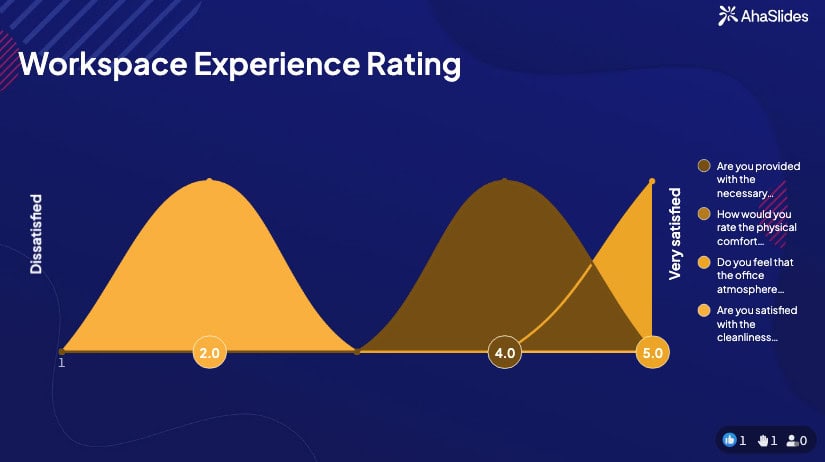
Eseye yon modèl sondaj sou anviwònman travay →
Responsablite Job
Kesyon:
- Èske responsablite travay ou kounye a aliman ak konpetans ou ak kalifikasyon ou?
- Èske travay ou yo byen defini epi kominike w?
- Èske ou gen opòtinite pou pran sou nouvo defi ak elaji konpetans ou?
- Èske w satisfè ak varyete ak konpleksite travay chak jou ou yo?
- Èske ou santi travay ou a ba ou yon sans de objektif ak satisfaksyon?
- Èske w satisfè ak nivo otorite pou pran desizyon ou genyen nan wòl ou a?
- Èske ou kwè responsablite travay ou yo aliyen ak objektif jeneral ak misyon òganizasyon an?
- Èske w bay gid klè ak atant pou travay ou ak pwojè yo?
- Ki jan ou santi responsablite travay ou kontribye nan siksè ak kwasans konpayi an?
Apwòch entèaktif ak AhaSlides:
- Prezante sondaj wi/non pou kesyon ki pi klè (pa egzanp, "Èske travay ou yo byen defini?")
- Sèvi ak echèl evalyasyon pou nivo satisfaksyon
- Swiv ak yon sesyon kesyon-repons ouvè: "Ki responsablite ou ta renmen ajoute oswa retire?"
- Kreye yon nyaj mo: "Dekri wòl ou an twa mo"
Pro pwent: Fonksyon kesyon-repons anonim lan patikilyèman puisan isit la. Anplwaye yo ka soumèt kesyon tankou "Poukisa nou pa gen plis otonomi nan pran desizyon?" san yo pa pè pou yo pa idantifye yo, sa ki pèmèt manadjè yo abòde pwoblèm sistemik yo ouvètman.
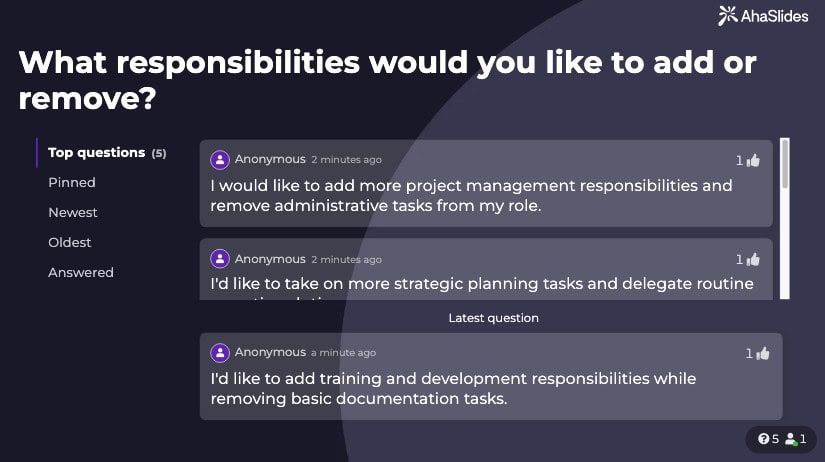
Sipèvizyon ak Lidèchip
Kesyon:
- Ki jan ou ta evalye kalite kominikasyon ant ou menm ak sipèvizè ou a?
- Èske w resevwa fidbak konstriktif ak konsèy sou pèfòmans ou a?
- Èske w ankouraje w pou bay sipèvizè w opinyon w ak sijesyon w?
- Èske ou santi sipèvizè ou a apresye kontribisyon ou yo epi rekonèt efò ou yo?
- Èske ou satisfè ak fason lidèchip ak apwòch jesyon nan depatman ou a?
- Ki kalite konpetans lidèchip ou panse ki t ap pi efikas nan ekip ou a?
Apwòch entèaktif ak AhaSlides:
- Sèvi ak echèl evalyasyon anonim pou fidbak sipèvizè sansib yo.
- Prezante opsyon estil lidèchip yo (demokratik, antrenè, transfòmasyonèl, elatriye) epi mande ki anplwaye ki prefere.
- Pèmèt kesyon ak repons an dirèk kote anplwaye yo ka poze kesyon sou apwòch jesyon an.
- Kreye klasman: "Ki sa ki pi enpòtan pou ou nan yon sipèvizè?" (Kominikasyon, Rekonesans, Fidbak, Otonomi, Sipò)
Poukisa anonimite enpòtan: Dapre fich travay pozisyonman ou an, pwofesyonèl RH yo bezwen "kreye espas ki an sekirite pou diskisyon onèt". Sondaj anonim entèaktif pandan reyinyon piblik yo pèmèt anplwaye yo evalye lidèchip onètman san yo pa gen pwoblèm karyè—yon bagay sondaj tradisyonèl yo pa rive reyalize yon fason konvenkan.
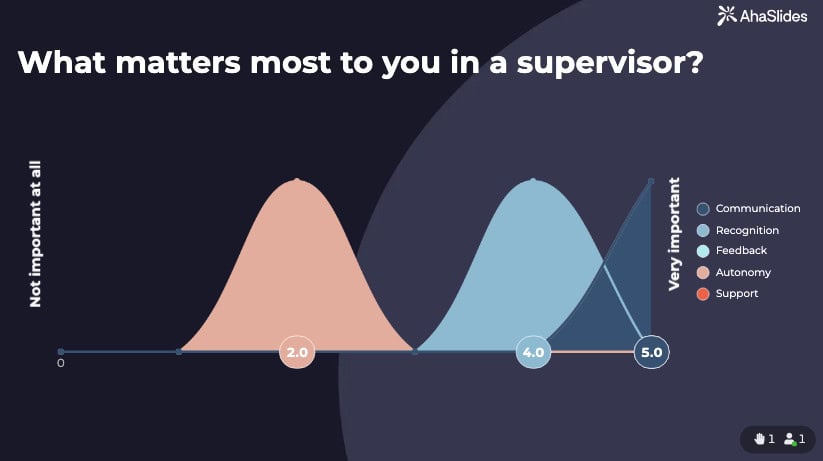
Kwasans Karyè ak Devlopman
Kesyon:
- Èske w bay opòtinite pou kwasans ak avansman pwofesyonèl?
- Nan ki nivo satisfaksyon ou genyen ak pwogram fòmasyon ak devlopman òganizasyon an ofri yo?
- Èske ou kwè ke wòl ou aktyèl aliman ak objektif karyè alontèm ou?
- Èske w ba w chans pou w pran wòl lidèchip oswa pwojè espesyal?
- Èske ou resevwa sipò pou pouswiv plis edikasyon oswa amelyore konpetans?
Apwòch entèaktif ak AhaSlides:
- Sondaj: "Ki kalite devlopman pwofesyonèl ki ta pi benefisye w?" (Fòmasyon lidèchip, Konpetans teknik, Sètifikasyon, Mentora, Avansman lateral)
- Nyaj mo: "Ki kote ou wè tèt ou nan 3 zan?"
- Echèl evalyasyon: "Nan ki nivo sipò ou santi nan devlopman karyè ou?" (1-10)
- Kesyon ak repons ouvè pou anplwaye yo ka poze kesyon sou opòtinite devlopman espesifik.
Avantaj estratejik: Kontrèman ak sondaj tradisyonèl yo kote done sa yo chita nan yon fichye kalkil, prezante kesyon devlopman karyè an dirèk pandan evalyasyon chak trimès pèmèt HR diskite imedyatman sou bidjè fòmasyon, pwogram mantora, ak opòtinite mobilite entèn pandan konvèsasyon an aktif.
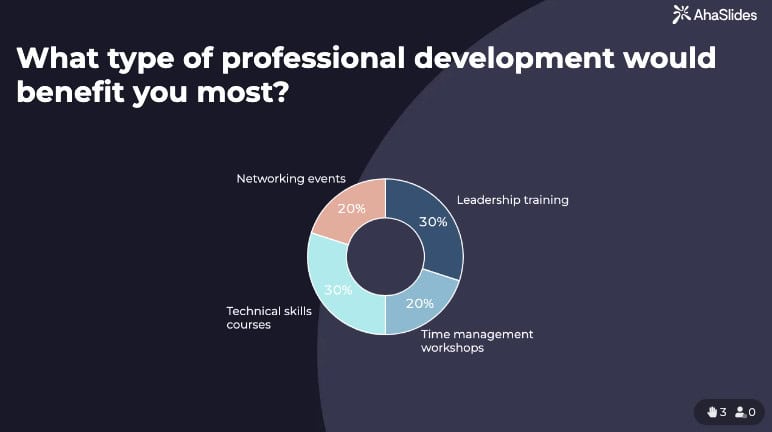
Konpansasyon ak Benefis
Kesyon:
- Èske w satisfè ak salè ou ak pake konpansasyon ou genyen kounye a, ki gen ladan benefis siplemantè?
- Èske w santi kontribisyon w ak reyalizasyon w yo rekonpanse kòmsadwa?
- Èske benefis òganizasyon an ofri yo konplè epi yo apwopriye pou bezwen ou yo?
- Ki jan ou ta evalye transparans ak jistis nan evalyasyon pèfòmans ak pwosesis konpansasyon an?
- Èske w satisfè ak opòtinite pou bonis, ankourajman oswa rekonpans?
- Èske ou satisfè ak règleman konje anyèl la?
Apwòch entèaktif ak AhaSlides:
- Sondaj anonim wi/non pou kesyon salè sansib
- Chwa miltip: "Ki benefis ki pi enpòtan pou ou?" (Swen sante, Fleksibilite, Bidjè aprantisaj, Pwogram byennèt, Retrèt)
- Echèl evalyasyon: "Ki nivo jistis konpansasyon nou an parapò ak kontribisyon ou an?"
- Nyaj mo: "Ki benefis ki ta amelyore satisfaksyon ou pi plis?"
Nòt kritik: Se la sondaj entèaktif anonim yo vrèman briye. Anplwaye yo raman bay fidbak onèt sou konpansasyon nan sondaj tradisyonèl yo ki mande enfòmasyon koneksyon. Sondaj anonim an dirèk pandan reyinyon piblik yo, kote repons yo parèt san non, kreye sekirite sikolojik pou fidbak otantik.
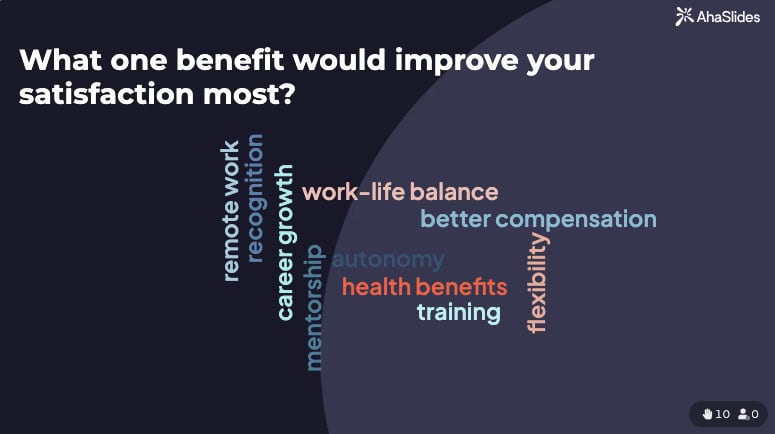
Kreye sesyon fidbak sou konpansasyon ou →
Relasyon ak Kolaborasyon
Kesyon:
- Ki jan ou byen kolabore ak kominike ak kòlèg ou yo?
- Èske ou santi yon sans de kamaradri ak travay ann ekip nan depatman ou a?
- Èske ou satisfè ak nivo respè ak kolaborasyon ki genyen ant kòlèg ou yo?
- Èske w gen opòtinite pou kominike avèk kòlèg ki soti nan diferan depatman oswa ekip?
- Èske ou konfòtab pou chèche èd oswa konsèy nan men kòlèg ou yo lè sa nesesè?
Apwòch entèaktif ak AhaSlides:
- Echèl evalyasyon pou kalite kolaborasyon
- Nyaj mo: "Dekri kilti ekip nou an nan yon sèl mo"
- Chwa miltip: "Konbyen fwa ou kolabore ant depatman yo?" (Chak jou, Chak semèn, Chak mwa, Raman, Pa janm)
- Kesyon ak repons anonim pou mete aksan sou pwoblèm entèpèsonèl
Byennèt ak Ekilib Travay-Lavi
Kesyon:
- Nan ki nivo satisfaksyon ou genyen ak balans ant travay ak lavi pèsonèl òganizasyon an ofri a?
- Èske ou santi ou sifizameman sipòte pa konpayi an nan jere estrès ak kenbe byennèt mantal ou?
- Èske ou konfòtab pou chèche asistans oswa resous pou jere defi pèsonèl oswa ki gen rapò ak travay?
- Konbyen fwa ou patisipe nan pwogram oswa aktivite byennèt ke òganizasyon an ofri?
- Èske ou kwè konpayi an bay byennèt anplwaye li yo valè epi li priyorize l?
- Èske ou satisfè ak anviwònman travay fizik la an tèm de konfò, ekleraj, ak ergonomics?
- Nan ki nivo òganizasyon an byen akomode bezwen sante ak byennèt ou yo (pa egzanp, orè fleksib, opsyon travay a distans)?
- Èske w santi w ankouraje w pran poz epi dekonekte w nan travay lè w bezwen rechaje?
- Konbyen fwa ou santi w akable oswa estrès akòz faktè ki gen rapò ak travay?
- Èske ou satisfè ak benefis sante ak byennèt òganizasyon an ofri yo?
Apwòch entèaktif ak AhaSlides:
- Echèl frekans: "Konbyen fwa ou santi ou strese?" (Pa janm, Raman, Pafwa, Souvan, Toujou)
- Sondaj wi/non sou sipò byennèt
- Kurseur anonim: "Bay yon nòt sou nivo epuizman ou ye kounye a" (1-10)
- Nyaj mo: "Ki sa ki ta amelyore byennèt ou pi plis?"
- Kesyon ak repons ouvè pou anplwaye yo pataje enkyetid byennèt yo anonimman
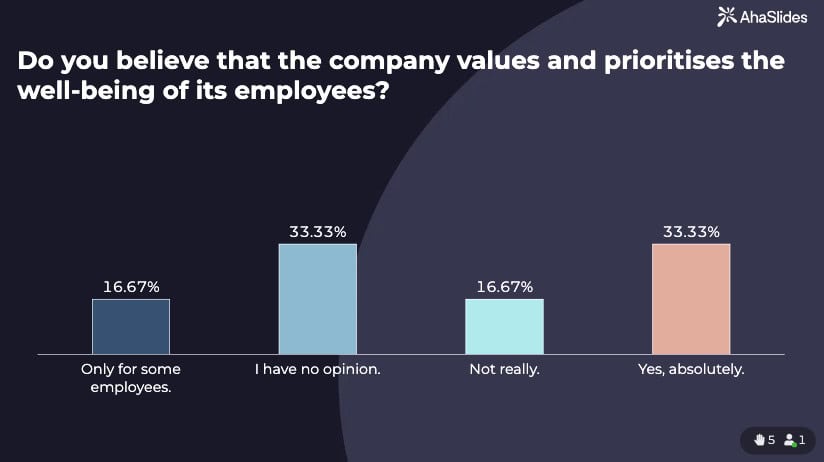
Poukisa bagay sa yo: Fèy travay pozisyonman ou an idantifye ke pwofesyonèl RH yo gen difikilte ak "angajman ak fidbak anplwaye yo" epi "kreye espas ki an sekirite pou diskisyon onèt". Kesyon byennèt yo sansib natirèlman—anplwaye yo pè parèt fèb oswa pa angaje si yo admèt yo boule pwofesyonèl. Sondaj anonim entèaktif yo retire baryè sa a.
Satisfaksyon an jeneral
Kesyon final la: 46. Sou yon echèl de 1 a 10, ki chans ou genyen pou rekòmande konpayi sa a kòm yon bon kote pou travay? (Employee Net Promoter Score)
Apwòch entèaktif:
- Fè swivi dapre rezilta yo: Si nòt yo ba, mande imedyatman "Ki sèl bagay nou ta ka chanje pou amelyore nòt ou a?"
- Montre eNPS la an tan reyèl pou lidèchip la wè santiman imedya a.
- Sèvi ak rezilta yo pou mennen yon konvèsasyon transparan sou amelyorasyon òganizasyonèl yo.
Kijan Pou Fè Yon Sondaj Satisfaksyon Travay Efikas Avèk AhaSlides
Etap 1: Chwazi fòma ou a
Opsyon A: An dirèk pandan reyinyon pou tout moun
- Prezante 8-12 kesyon kle pandan reyinyon piblik chak twa mwa yo
- Sèvi ak mòd anonim pou sijè sansib yo
- Diskite rezilta yo imedyatman avèk gwoup la
- Pi bon pou: Bati konfyans, aksyon imedya, rezoud pwoblèm an kolaborasyon
Opsyon B: Nan pwòp rit ou men entèaktif
- Pataje yon lyen prezantasyon anplwaye yo ka jwenn aksè nenpòt ki lè
- Mete tout 46 kesyon yo òganize pa kategori
- Mete yon dat limit pou fini
- Pi bon pou: Koleksyon done konplè, tan fleksib
Opsyon C: Apwòch ibrid (rekòmande)
- Voye 5-7 kesyon enpòtan kòm sondaj nan pwòp rit ou.
- Prezante rezilta yo ak 3 pi gwo enkyetid yo an dirèk nan pwochen reyinyon ekip la.
- Sèvi ak kesyon ak repons an dirèk pou fouye pi fon nan pwoblèm yo
- Pi bon pou: Patisipasyon maksimòm ak diskisyon ki gen sans
Etap 2: Mete Sondaj ou a an plas nan AhaSlides
Karakteristik pou itilize:
- Echèl evalyasyon pou nivo satisfaksyon
- Biwo vòt chwa miltip pou kesyon preferans
- Nwaj mo pou vizyalize tèm komen yo
- Kesyon ak Repons Ouvè pou anplwaye yo poze kesyon anonim
- Mòd anonim pou asire sekirite sikolojik
- Ekspozisyon rezilta an dirèk pou montre transparans
Konsèy pou ekonomize tan: Sèvi ak dèlko IA AhaSlides la pou kreye sondaj ou rapidman apati lis kesyon sa a, epi pèsonalize li selon bezwen espesifik òganizasyon w lan.
Etap 3: Kominike Objektif la
Anvan ou lanse sondaj ou a, eksplike:
- Poukisa w ap fè l (pa sèlman "paske li lè pou sondaj anyèl yo")
- Kijan repons yo pral itilize
- Ke repons anonim yo vrèman anonim
- Kilè ak kijan ou pral pataje rezilta yo epi pran aksyon
Senaryo pou bati konfyans: "Nou vle konprann kijan ou santi w tout bon vre konsènan travay isit la. N ap itilize sondaj entèaktif anonim paske nou konnen sondaj tradisyonèl yo pa pran fidbak onèt ou. Repons ou yo parèt san non, epi n ap diskite rezilta yo ansanm pou nou devlope solisyon an kolaborasyon."
Etap 4: Prezante an dirèk (si sa aplikab)
Estrikti reyinyon an:
- Entwodiksyon (2 minit): Eksplike objektif la ak anonimite a
- Kesyon sondaj (15-20 minit): Prezante sondaj yo youn pa youn, ap montre rezilta an dirèk
- Diskisyon (15-20 minit): Adrese pi gwo enkyetid yo imedyatman
- Planifikasyon aksyon (10 minit): Angaje w nan pwochen etap espesifik yo
- Sesyon kesyon ak repons apre sa (10 minit): Sesyon ouvè pou kesyon anonim
Pro pwent: Lè rezilta sansib parèt (pa egzanp, 70% evalye kominikasyon lidèchip la kòm pòv), rekonèt yo imedyatman: "Sa a se yon fidbak enpòtan. Ann diskite sou sa 'pòv kominikasyon' vle di pou ou. Sèvi ak kesyon ak repons yo pou pataje egzanp espesifik anonimman."
Etap 5: Aji sou Rezilta yo
Se la sondaj entèaktif yo kreye avantaj konpetitif. Paske ou te rasanble fidbak pandan konvèsasyon an dirèk:
- Anplwaye yo deja wè rezilta yo
- Ou angaje w pou w fè aksyon piblikman
- Swivi a espere e vizib.
- Konfyans bati lè pwomès yo kenbe
Modèl plan aksyon:
- Pataje rezilta detaye yo nan 48 èdtan
- Idantifye 3 pi gwo domèn pou amelyorasyon
- Fòme gwoup travay pou devlope solisyon
- Kominike pwogrè chak mwa
- Fè yon lòt sondaj nan 6 mwa pou mezire amelyorasyon an
Poukisa Sondaj Entèaktif yo Fonksyone Pi Byen Pase Fòm Tradisyonèl yo
Selon bezwen òganizasyon w lan, ou bezwen:
- Mezire angajman anplwaye yo pandan inisyativ RH yo
- "Fasilite sesyon kesyon-repons anonim nan asanble minisipal yo"
- "Kolekte santiman anplwaye yo lè l sèvi avèk nyaj mo ak sondaj an dirèk"
- "Kreye espas ki an sekirite pou diskisyon onèt"
Zouti sondaj tradisyonèl tankou Google Forms oubyen SurveyMonkey pa ka bay eksperyans sa a. Yo kolekte done, men yo pa kreye dyalòg. Yo rasanble repons, men yo pa bati konfyans.
Platfòm entèaktif tankou AhaSlides transfòme koleksyon fidbak soti nan yon egzèsis biwokratik an yon konvèsasyon ki gen sans. kote:
- Anplwaye yo wè vwa yo enpòtan an tan reyèl.
- Lidè yo demontre yon angajman imedya pou koute
- Anonimite retire laperèz pandan transparans bati konfyans.
- Diskisyon mennen nan solisyon kolaboratif
- Done yo vin tounen yon fason pou kòmanse yon konvèsasyon, pa yon rapò ki rete nan yon tiwa.
Kle Takeaways
✅ Sondaj satisfaksyon travay yo se zouti estratejik, pa kaz administratif. Yo revele sa ki motive angajman, retansyon, ak pèfòmans.
✅ Sondaj entèaktif yo bay pi bon rezilta pase fòm tradisyonèl yo—pi gwo pousantaj repons, plis fidbak onèt, ak opòtinite pou diskisyon imedya.
✅ Anonimite plis transparans kreye sekirite sikolojik ki nesesè pou yon fidbak otantik. Anplwaye yo reponn onètman lè yo konnen repons yo anonim men yo wè ke lidè yo ap pran aksyon.
✅ 46 kesyon ki nan gid sa a kouvri dimansyon kritik yo satisfaksyon travay: anviwònman, responsablite, lidèchip, kwasans, konpansasyon, relasyon, ak byennèt.
✅ Rezilta an tan reyèl pèmèt aksyon imedya. Lè anplwaye yo wè fidbak yo vizyalize imedyatman epi diskite ouvètman, yo santi yo tande yo olye ke yo jis sonde yo.
✅ Zouti yo enpòtan. Platfòm tankou AhaSlides ak sondaj an dirèk, nyaj mo, kesyon/repons anonim, ak ekspozisyon rezilta an tan reyèl transfòme kesyonè estatik an konvèsasyon dinamik ki kondwi chanjman òganizasyonèl.
Referans:




